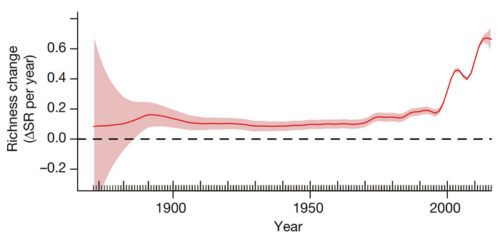
Over the past two decades we have (1) reviewed several papers (see Extinction (Migrating Plants) and Extinction (Stationary Plants)), (2) published a major report and (3) produced a video documentary examining this claim.
Through these efforts, we have learned that it is easy to make long-term predictions, but to substantiate them with facts is an entirely different matter.
And even when the facts are largely in hand, one can still be blinded by preconceived ideas that make it difficult to comprehend the real meaning of what has been discovered.
So it is with the specter of species extinction that hovers over the global warming debate. The vast majority of people who have studied the subject have not understood some of the issue’s most basic elements, and they have consequently drawn conclusions that are not aligned with reality.
Proponents of what we shall call the CO2-induced global warming extinction hypothesis seem to be totally unaware of the fact that atmospheric CO2 enrichment tends to ameliorate the deleterious effects of rising temperatures on earth’s vegetation.
They appear not to know that more CO2 in the air enables plants to grow better at nearly all temperatures, but especially at higher temperatures.
They feign ignorance of the knowledge (or truly do not know) that elevated CO2 boosts the optimum temperature at which plants grow best and that it raises the upper-limiting temperature above which they experience death, making them much more resistant to heat stress.
The end result of these facts is that if the atmosphere’s temperature and CO2 concentration rise together, plants are able to successfully adapt to the rising temperature, and they experience no ill effects of the warming.
Under such conditions, plants living near the heat-limited boundaries of their ranges do not experience an impetus to migrate poleward or upward towards cooler regions of the globe.
At the other end of the temperature spectrum, however, plants living near the cold-limited boundaries of their ranges are empowered to extend their ranges into areas where the temperature was previously too low for them to survive.
And as they move into those once-forbidden areas, they actually expand their ranges, overlapping the similarly-expanding ranges of other plants and thereby increasing local plant biodiversity.
Vindication of our thesis has been gaining momentum year by year, as scientists have published papers examining this topic using real-world data (see the many reviews we have archived in our Subject Index under the following headings: Alpine Ecosystems, Extinction, and Range Expansion).
The latest such work comes from the 53-member research team of Steinbauer et al. (2018).*
Publishing in the journal Nature, this new group of scientists analyzed a massive continent-wide dataset of repeated plant surveys from 302 mountain summits across Europe dating all the way back to 1871 in an effort to “assess the temporal trajectory of mountain biodiversity changes.”
Vegetation surveys were conducted predominately on the uppermost 10 m of elevation on each summit during the summer, with each summit being resurveyed between one to six times between 1871 and 2016, for a total of 698 surveys over the period of study.
Such surveys, in the words of the authors, were “optimal … for detecting changes in plant species richness over time.”
So what did the records show? Has the global warming of the past century and a half driven plants in such mountaintop ecosystems toward extinction?
In a word, no!
Contrary to climate alarmist contentions and model-based predictions, Steinbauer et al. report there has been “a continent-wide acceleration in the rate of increase in plant species richness, with five times as much species enrichment between 2007 and 2016 as fifty years ago, between 1957 and 1966” (see Figure 1 below).
What is more, they note that this incredible trend of increasing biodiversity was “consistent across all [continental regions], with no single region showing the opposite pattern.”
Nevertheless, despite such good news rooted in real-world observations, the team of researchers just can’t seem to bring themselves to reject the CO2-induced global warming extinction hypothesis.
Appearing to be still blinded by their preconceived ideas, they opine that “accelerating plant species richness increases are expected to be a transient phenomenon that hides the accumulation of a so-called extinction debt,” where “a rapid loss of alpine-nival species may occur under accelerated global warming.”
So sad!
*Paper Reviewed
Steinbauer, M.J., Grytnes, J.-A., Jurasinski, G., Kulonen, A., Lenoir, J., Pauli, H., Rixen, C., Winkler, M., Bardy-Durchhalter, M., Barni, E., Bjorkman, A.D., Breiner, F.T., Burg, S., Czortek, P., Dawes, M.A., Delimat, A., Dullinger, S., Erschbamer, B., Felde, V.A., Fernández-Arberas, O., Fossheim, K.F., Gómez-García, D., Georges, D., Grindrud, E.T., Haider, S., Haugum, S.V., Henriksen, H., Herreros, M.J., Jaroszewicz, B., Jaroszynska, F., Kanka, R., Kapfer, J., Klanderud, K., Kühn, I., Lamprecht, A., Matteodo, M., Morra di Cella, U., Normand, S., Odland, A., Olsen, S.L., Palacio, S., Petey, M., Piscová, V., Sedlakova, B., Steinbauer, K., Stöckli, V., Svenning, J.-C., Teppa, G., Theurillat, J.-P., Vittoz, P., Woodin, S.J., Zimmermann, N.E. and Wipf, S. 2018. Accelerated increase in plant species richness on mountain summits is linked to warming. Nature 556: 231-234.

Read more at CO2 Science



















This author is wrong. He states that higher levels of carbon dioxide mitigate the increasing temperature. The trouble with that is the temperature hasn’t increased enough to need mitigation. The increase in temperature is less than the variability that often happens from one year to another.
The article does have a valid point as far as the impact of increased levels of carbon dioxide. Think about water for a moment. A dry desert doesn’t have as much biodiversity as a wet jungle. As a needed ingredient of life no longer is scarce, biodiversity increases. It appears the same is true for carbon dioxide. Going from 350 to 400 ppm has resulted in greening of the earth and according to this article has improved biodiversity. This also implies that increasing carbon dioxide to higher levels will continue to improve biodiversity.
It is obvious that plants and animal diversity thrive in periods of warming . Why then are the eco-anarchist’s and other rent seekers against such positive change ?
1. They don’t actually believe the planet is in danger of having a fever .
2. Global warming(climate change rebranded ) fear mongering is just a means to an end . A money making scheme to fleece tax payers under the pretence of saving the planet .
3. Globalist (formerly socialists/communists) needed a new platform to push their agenda and the globalists at the cash hungry UN were happy to play ball . The UN
as admitted as much when Commie lover Maurice Strong yapped about it at the beginning of the scam .
4. Businesses love to have government subsidize and eliminate risk. What better way than “renewable energy” subsidies and carbon trading mandated by government .
5. There are those who see population elimination as a religious goal . Nut job
solutions like those expressed in the “Population Bomb ” book call for the “humane “elimination of people through various techniques .
Bring on any warming we can get and celebrate it because whatever eliminated all those wholly mammoth’s will surely return someday . Then we will have something to fret about .
All this Fragile Earth and Delicate Balance of Nature poppycock from the En-Liar-Mentalists all this bunk about uncounted spiece’s going extinct a minute is just like all their lies about the Rain Forests back in the 1990’s